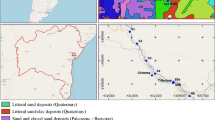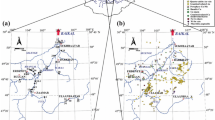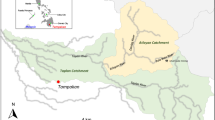Abstract
Mine waste is recognized as being one of the most serious threats for freshwater ecosystems, and it still represents one of the greatest environmental concerns in Macedonia. The aim of our investigation was to obtain an in-depth understanding of mining influence on freshwater systems from water contamination to effects on aquatic organisms. In this study, we assessed the impact of active lead (Pb)/zinc (Zn) mines Zletovo and Toranica on the water quality of three rivers in northeastern Macedonia (Bregalnica, Zletovska, and Kriva rivers) based on data collected in spring and autumn of 2012. The Bregalnica River, near Shtip, was characterized mainly by weak contamination with arsenic, barium, iron, molybdenum, titanium, uranium, vanadium, nitrate, and phosphate, as well as critical faecal pollution, which alltogether could be connected to agricultural activities; however, an impact of the mines was not observed. Contrary, both the Zletovska and Kriva rivers showed a clear impact of Pb/Zn mines on water quality. In the Zletovska River, increased concentrations of cadmium (Cd), cobalt, cesium, copper, lithium, manganese (Mn), nickel, rubidium, tin, strontium, thallium, Zn, sulphates, and chlorides were found, especially in autumn (e.g., Cd 2.0 μg L−1; Mn 2.5 mg L−1; Zn 1.5 mg L−1). In the Kriva River, increased Cd (0.270 μg L−1) and Pb (1.85 μg L−1) concentrations were found only in spring, possibly due to sediment resuspension during greater water discharge. The selected sampling sites on the Bregalnica, Zletovska, and Kriva rivers were confirmed as being appropriate locations for further studies of mining waste’s impact on freshwater ecosystems, the first one as a nonimpacted site and the other two as possible areas of increased exposure of aquatic organisms to metals.



Similar content being viewed by others
References
Alderton DHM, Serafimovski T, Mullen B, Fairall K, James S (2005) The chemistry of waters associated with metal mining in Macedonia. Mine Water Environ 24:139–149
American Public Health Association (1998) Standard methods for the examination of water and waste water (20th ed). APHA, Washington, DC
Anke MK, Seifert M (2004) Titanium. In: Merian E, Anke M, Ihnat M, Stoeppler M (eds) Elements and their compounds in the environment, vol 2., Metals and their compounds. Wiley, Weinheim, pp 1125–1140
Aykol A, Budakoglu M, Kumral M, Gultekin AH, Turhan M, Esenli V et al (2003) Heavy metal pollution and acid drainage from the abandoned Balya Pb-Zn sulfide mine, NW Anatolia, Turkey. Environ Geol 45:198–208
Barnes HL (1979) The solubilities of ore minerals. In: Barnes HL (ed) The geochemistry of hydrothermal ore deposits, 2nd edn. Wiley, New York, pp 404–460
Bednar AJ, Garbarino JR, Ranville JF, Wildeman TR (2002) Presence of organoarsenicals used in cotton production in agricultural water and soil of the southern United States. J Agric Food Chem 50:7340–7344
Bird G, Brewer PA, Macklin MG, Nikolova M, Kotsev T, Mollov M et al (2010) Dispersal of contaminant metals in the mining-affected Danube and Maritsa drainage basins, Bulgaria, Eastern Europe. Water Air Soil Pollut 206:105–127
Bolan NS, Adriano DC, Mahimairaja S (2004) Distribution and bioavailability of trace elements in livestock and poultry manure by-products. Crit Rev Environ Sci Technol 34:291–338
Braungardt CB, Achterberg EP, Elbaz-Poulichet F, Morley NH (2003) Metal geochemistry in a mine-polluted estuarine system in Spain. Appl Geochem 18:1757–1771
Byrne P, Reid I, Wood PJ (2010) Sediment geochemistry of streams draining abandoned lead/zinc mines in central Wales: The Afon Twymyn. J Soil Sed 10:683–697
Byrne P, Wood PJ, Reid I (2012) The impairment of river systems by metal mine contamination: A review including remediation options. Crit Rev Environ Sci Technol 42:2017–2077
Carpenter SR, Caraco NF, Correll DL, Howarth RW, Sharpley AN, Smith VH (1998) Nonpoint pollution of surface waters with phosphorus and nitrogen. Ecol Appl 8:559–568
Cerqueira B, Vega FA, Serra C, Silva LFO, Andrade ML (2011) Time of flight secondary ion mass spectrometry and high-resolution transmission electron microscopy/energy dispersive spectroscopy: a preliminary study of the distribution of Cu2+ and Cu2+/Pb2+ on a Bt horizon surfaces. J Hazard Mater 195:422–431
Cokgor EU, Oktay S, Tas DO, Zengin GE, Orhon D (2009) Influence of pH and temperature on soluble substrate generation with primary sludge fermentation. Bioresour Technol 100:380–386
Cooper S, Fortin C (2010) Metal and metallothionein content in bullfrogs: study of a whole watershed impacted by agricultural activities. Ecotoxicol Environ Safe 73:391–399
Council of the European Communities (1976) Council Directive of 8 December 1975 concerning the quality of bathing water (76/160/EEC). Official J L 31
Crane M, Kwok KWH, Wells C, Whitehouse P, Lui GCS (2007) Use of field data to support European water framework directive quality standards for dissolved metals. Environ Sci Technol 41:5014–5021
Dautović J (2006) Determination of metals in natural waters using high resolution inductively coupled plasma mass spectrometry. Bachelor’s thesis, University of Zagreb, Zagreb
Dolenec T, Serafimovski T, Dobnikar M, Tasev G, Dolenec M (2005) Mineralogical and heavy metal signature of acid mine drainage impacted paddy soil from the western part of the Kočani field (Macedonia). RMZ Mater Geoenviron 52:397–402
Dragun Z, Roje V, Mikac N, Raspor B (2009) Preliminary assessment of total dissolved trace metal concentrations in Sava River water. Environ Monit Assess 159:99–110
Dragun Z, Kapetanović D, Raspor B, Teskeredžić E (2011) Water quality of medium size watercourse under baseflow conditions: The case study of river Sutla in Croatia. Ambio 40:391–407
Edberg SC, Allen MJ, Smith DB, Kriz NJ (1990) Enumeration of total coliforms and Escherichia coli from source water by the defined substrate technology. Appl Environ Microbiol 56:366–369
Environment Agency (2006) Attenuation of mine pollutants in the hyporheic zone. Environment Agency, Bristol
European Parliament and the Council of the European Union (2006) Directive 2006/7/EC of the European Parliament and of the Council of 15 February 2006 concerning the management of bathing water quality and repealing Directive 76/160/EEC. Official J L 64/37
European Parliament and the Council of the European Union (2008) Directive 2008/105/EC of the European Parliament and of the Council on environmental quality standards in the field of water policy, amending and subsequently repealing Council Directives 82/176/EEC, 83/513/EEC, 84/156/EEC, 84/491/EEC, 86/280/EEC, and amending Directive 2000/60/EC of the European Parliament and of the Council. Official J L 348/84
Fidancev B, Ilievski D, Kostadinov L, Straseski A (2011) Substitution of the conventional method with a new method for building the future over height flotation tailing disposal from Toranica lead and zinc mine, Kr. Palanka, Macedonia. XIV Balkan Mineral Processing Congress, Tuzla
Findlay S, Tank J, Dye S, Valett HM, Mulholland PJ, McDowell WH et al (2002) Cross-system comparison of bacteria and fungal biomass in detritus pools of headwater streams. Microbial Ecol 43:55–66
Government of the Republic of Macedonia (1999) Regulation for classification of water. Official Gazette of the Republic of Macedonia No. 18/99
Gray NF (1996) Field assessment of acid mine drainage contamination in surface and groundwater. Environ Geol 27:358–361
Holmstrom H, Ljungberg J, Ohlander B (1998) Role of carbonate in mitigation of metal release from mining waste: Evidence from humidity cells tests. Environ Geol 37:267–280
Hudson-Edwards KA, Macklin MG, Curtis CD, Vaughn DJ (1996) Processes of formation and distribution of Pb, Zn, Cd and Cu bearing minerals in the Tyne Basin, northeast England: Implications for metal-contaminated river systems. Environ Sci Technol 30:72–80
Hudson-Edwards KA, Schell C, Macklin MG (1999) Mineralogy and geochemistry of alluvium contaminated by metal mining in the Rio Tinto area, southwest Spain. Appl Geochem 14:1015–1030
Huet M (1986) Text book of fish culture, 2nd edn. Fishing News Book Ltd., Farnham
Jackson BP, Bertsch PM (2001) Determination of arsenic speciation in poultry wastes by IC-ICP-MS. Environ Sci Technol 35:4868–4873
Jackson BP, Bertsch PM, Cabrera ML, Camberato JJ, Seaman JC, Wood CW (2003) Trace element speciation in poultry litter. J Environ Qual 32:535–540
Jain CK (2004) Metal fractionation study on bed sediments of the River Yamuna, India. Water Res 38:569–578
Jiménez A, Aroba J, de la Torre ML, Andujar JM, Grande JA (2009) Model of behaviour of conductivity versus pH in acid mine drainage water, based on fuzzy logic and data mining techniques. J Hydroinform 11:147–153
Kapetanović D, Dragun Z, Vardić Smrzlić I, Valić D, Teskeredžić E (2013) The microbial marine water quality associated with capture-based bluefin tuna aquaculture: a case study in Adriatic Sea (Croatia). Fres Environ Bull 22:2214–2220
Kavka GG, Kasimir GD, Farnleitner AH (2006) Microbiological water quality of the River Danube (km 2581–km 15): Longitudinal variation of pollution as determined by standard parameters. Proceedings of 36th International Conference of IAD. Austrian Committee Danube Research/IAD, Vienna, pp 415–421
Korhonen LK, Martikainen PJ (1991) Survival of Escherichia coli and Campylobacter jejuni in untreated and filtered lake water. J Appl Bacteriol 71:379–382
Lapakko K (2002) Metal mine rock and waste characterization tools: An overview, mining, minerals and sustainable development, No. 67. Available at: http://pubs.iied.org/pdfs/G00559.pdf. Accessed: April 2002
Lata P, Ram S, Agrawal M, Shanker R (2009) Enterococci in river Ganga surface waters: Propensity of species distribution, dissemination of antimicrobial-resistance and virulence-markers among species along landscape. BMC Microbiol 9:140–149
Lee G, Bigham JM, Faure G (2002) Removal of trace elements with Fe, Al and Mn from natural waters contaminated with acid mine drainage in the Ducktown mining district, Tennessee. Appl Geochem 17:569–581
Lewin J, Macklin MG (1987) Metal mining and floodplain sedimentation in Britain. In: Gardiner V (ed) International geomorphology 1986 Part I. Wiley, London, pp 1009–1027
Macklin MG, Brewer PA, Hudson-Edwards KA, Bird G, Coulthard TJ, Dennis IA (2006) A geomorphological approach to the management of rivers contaminated by metal mining. Geomorphology 79:423–447
Marcus WA (1987) Copper dispersion in ephemeral stream sediments. Earth Surf Proc Land 12:217–228
Midžić S, Silajdžić I (2005) Macedonia. In: Wolkersdorfer C, Bowell R (eds) Contemporary reviews of mine water studies in Europe Part 2. Mine Water Environ 24:2–37
Milevski J, Karamanolevski Z, Tognacca C (2004) RIMSYS—river monitoring system. BALWOIS, Ohrid, pp 1–10
Nash D, Halliwell D, Hannah M, Clemow L, Webb B (2003) Phosphorus and selected metals mobilized from two commercial fertilizers into overland flow during border irrigation. Nutr Cycl Agroecosyst 67:255–264
Neal C, Williams RJ, Neal M, Bhardwaj LC, Wickham H, Harrow M et al (2000) The water quality of the River Thames at a rural site downstream of Oxford. Sci Total Environ 251–252:441–457
Nordstrom DK, Alpers CN (1997) The environmental geochemistry of mineral deposits Part A. Processes, methods and health issues. In: Plumlee GS, Logsdon MJ (eds) Reviews in economic geology. vol. 6. Society of Economic Geologists, Littleton, CO.
Peña-Méndez EM, Havel J, Patočka J (2005) Humic substances. Compounds of still unknown structure: application in agriculture, industry, environment and biomedicine. J Appl Biomed 3:13–24
Rebok K (2013) A toxicopathology survey of the River Bregalnica using the barbel (Barbus peloponnesius, Valenciennes 1844) as bioindicator. Doctoral Thesis, University Ss. Cyril and Methodius, Skopje, Macedonia
Ribeiro J, DaBoit K, Flores D, Kronbauer MA, Silva LFO (2013a) Extensive FE-SEM/EDS, HR-TEM/EDS and ToF-SIMS studies of micron- to nano-particles in anthracite fly ash. Sci Total Environ 452–453:98–107
Ribeiro J, Taffarel SR, Sampaio CH, Flores D, Silva LFO (2013b) Mineral speciation and fate of some hazardous contaminants in coal waste pile from anthracite mining in Portugal. Int J Coal Geol 109–110:15–23
Robb GA, Robinson JDF (1995) Acid drainage from mines. Geogr J 161:47–54
Roje V (2008) Determination of metals in environmental samples by inductively coupled plasma-mass spectrometry. Doctoral thesis, University of Zagreb, Zagreb
Sachs S, Brendler V, Geipel G (2007) Uranium(VI) complexation by humic acid under neutral pH conditions studied by laser-induced fluorescence spectroscopy. Radiochim Acta 95:103–110
Sarmiento AM, DelValls A, Nieto JM, Salamanca MJ, Caraballo MA (2011) Toxicity and potential risk assessment of a river polluted by acid mine drainage in the Iberian Pyrite Belt (SW Spain). Sci Total Environ 409:4763–4771
Senesi N, Polemio M, Lorusso L (1983) Evaluation of barium, rubidium and strontium contents in commercial fertilizers. Fertil Res 4:135–144
Serafimovski T, Dolenec T, Tasev G (2006) New data concerning the major ore minerals and sulphosalts from Pb-Zn Zletovo Mine, Macedonia. RMZ Mater Geoenviron 52:535–548
Serafimovski T, Dolenec T, Tasev G, Dolenec M, Rogan N (2007) Acid mine drainage systems and metal pollution around the active polymetallic mines in the Eastern Macedonia. Geol Maced 21:69–73
Silva LFO, Izquierdo M, Querol X, Finkelman RB, Oliveira MLS, Wollenschlager M et al (2011a) Leaching of potential hazardous elements of coal cleaning rejects. Environ Monit Assess 175:109–126
Silva LFO, Querol X, da Boit KM, Fdez-Ortiz de Vallejuelo S, Madariaga JM (2011b) Brazilian coal mining residues and sulphide oxidation by Fenton’s reaction: An accelerated weathering procedure to evaluate possible environmental impact. J Hazard Mater 186:516–525
Silva LFO, Wollenschlager M, Oliveira MLS (2011c) A preliminary study of coal mining drainage and environmental health in the Santa Catarina region, Brazil. Environ Geochem Health 33:55–65
Silva LFO, Fdez-Ortiz de Vallejuelo S, Martinez-Arkarazo I, Correa OK, Oliveira MLS et al (2013) Study of environmental pollution and mineralogical characterization of sediment rivers from Brazilian coal mining acid drainage. Sci Total Environ 447:169–178
Smith H, Wood PJ, Gunn J (2003) The influence of habitat structure and flow permanence on invertebrate communities in karst spring systems. Hydrobiologia 510:53–66
Spasovski O (2011) Heavy and toxic metals and nutrients in separate places in the river Bregalnica, (eastern Macedonia). Annual of the University of Mining and Geology St. Ivan Rilski. vol. 54. Part II: Mining and mineral processing. pp 118–120
Spasovski O (2012) Potential and geochemical characteristics of geothermal resources in Eastern Macedonia. In: Panagiotaras D (ed) Geochemistry—Earth’s system processes. InTech, Rijeka, pp 291–322
Spasovski O, Dambov R (2009) Heavy metals in the water of the river Kalnistanska and the vicinity. Balkanmine 2009—3rd Balkan Mining Congress. Izmir, Turkey, pp 667–670
Stuhlberger C (ed) (2010) Mining and environment in the Western Balkans. Zoï Environment Network, Geneva
Stumm W, Morgan JJ (1981) Aquatic chemistry—An introduction emphasizing chemical equilibria in natural waters. Wiley, New York, p 470
Vachirapatama N, Macka M, Haddad PR (2002) Separation and determination of vanadium in fertiliser by capillary electrophoresis with a light-emitting diode detector. Anal Bioanal Chem 374:1082–1085
Wolfenden PJ, Lewin J (1978) Distribution of metal pollutants in active stream sediments. Catena 5:67–78
Zhang G, Liu C-Q, Yang Y, Wu P (2004) Characterization of heavy metals and sulphur isotope in water and sediments of a mine-tailing area rich in carbonate. Water Air Soil Pollut 155:51–62
Acknowledgments
This study was performed as a part of two bilateral projects between Macedonia and Croatia entitled “The Assessment of the Availability and Effects of Metals on Fish in the Rivers Under the Impact of Mining Activities” and “Bacterial and Parasitical Communities of Chub as Indicators of the Status of Environment Exposed to Mining Activities.” The authors are grateful to project participants Vlatka Filipović Marijić, Damir Valić, Katerina Rebok, and Nesrete Krasnići, for valuable assistance in the field. Financial support by the Ministry of Science, Education and Sport of the Republic of Croatia (Projects No. 098-0982934-2721 and 098-0982934-2752) is acknowledged. The hydrological data were obtained courtesy of the Hydrometeorological Service of the Republic of Macedonia. The authors are especially thankful to Nevenka Mikac for the opportunity to use HR ICP-MS and to Željka Fiket for insightful contribution to the discussion.
Author information
Authors and Affiliations
Corresponding author
Rights and permissions
About this article
Cite this article
Ramani, S., Dragun, Z., Kapetanović, D. et al. Surface Water Characterization of Three Rivers in the Lead/Zinc Mining Region of Northeastern Macedonia. Arch Environ Contam Toxicol 66, 514–528 (2014). https://doi.org/10.1007/s00244-014-0012-z
Received:
Accepted:
Published:
Issue Date:
DOI: https://doi.org/10.1007/s00244-014-0012-z




